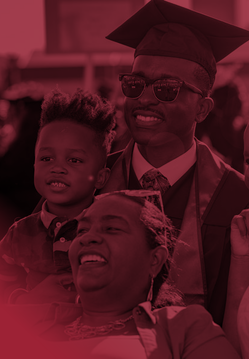Explore our resources for teaching and education degrees and learn about career options that fit your future.

Today’s classrooms are becoming increasingly diverse — and this trend shows no signs of stopping. The National Center for Education Statistics (NCES) predicts the portion of public elementary and secondary school students who are white will decrease to 44 percent by 2029 as the share of minority students continues to grow. This scenario presents a unique opportunity for teachers.
While educators like you are committed to ensuring every student receives the same caliber of instruction, it’s impossible to deny the barriers that students of color face. For years, research has shown that these hurdles result in minority students being more likely to struggle academically, drop out of school and experience disciplinary action.
The solution isn’t as simple as educating every learner in exactly the same way. Dr. Hawani Negussie, assistant professor of early childhood education at University of Massachusetts Global, says teachers need to go the extra step of gaining a deeper sense of who each student is.
“Treating all kids the same means understanding where those children are coming from,” she offers. “Once you understand how marginalized communities live, then you can really bring who they are to the forefront in the classroom.”
To properly support students of color, you need to make a concerted effort. Dr. Negussie recommends teachers leverage culturally relevant pedagogy, which can help all students achieve success. Keep reading to deepen your understanding of this approach and how to apply it in your classroom.
Exploring Culturally Relevant Pedagogy and How It Supports Students of Color
According to a recent University of Massachusetts Global webinar, the first step toward adequately supporting students of color is to understand that the system itself is fundamentally inequitable. Unfortunately, society has reinforced this divide again and again. Dr. Negussie provides an illustration of how this can happen in the classroom.
“When we make one group more dominant in the books we use, we’re telling the other groups they don’t belong,” She explains. “And the children who are represented in those books are unknowingly growing with the idea that they matter more.”
Only after acknowledging the systemically inherent obstacles minority students are up against is it possible to start working toward a learning environment that’s effective for every student. This is exactly what pioneering teacher and researcher Dr. Gloria Ladson-Billings did beginning in the 1990s. Dr. Ladson-Billings began looking for ways to close the achievement gap by studying teachers whose students of color were actually quite successful. Some commonalities emerged, which informed the framework for what she termed “culturally relevant pedagogy.” According to Dr. Ladson-Billings, there are three main pillars that support this approach to education:
- Academic success — Facilitating intellectual growth among students as a result of their classroom learning experiences.
- Cultural competence — Helping students recognize and celebrate their own culture while gaining knowledge and appreciation for those of others.
- Sociopolitical consciousness — Demonstrating how classroom knowledge and skills can be applied to identify and solve real-life problems.
There’s plenty of evidence to suggest this approach to education is effective. Research has shown that culturally relevant education can improve academic outcomes and helps students develop a sense of racial identity. One study even shows that culturally responsive teaching is associated with positive student behavior. From a logical perspective, this all makes sense.
“When we connect lessons to who students are, then they’re able to integrate or assimilate whatever it is they’re being taught in a more profound way,” Dr. Negussie says. “By profound, I mean they can connect it to their learned experiences, which they can now translate into knowledge.”
It’s also important to remember that, when leveraged properly, culturally relevant teaching creates a more inclusive classroom that benefits all students. It helps students learn not only from you, but also from one another.
How to Implement Culturally Relevant Pedagogy in Your Classroom
You’re not alone if you feel intimidated about moving toward a more equitable classroom. But keep in mind that even small improvements can help. Dr. Negussie recommends teachers get started by reading material from experts like Dr. Gloria Ladson-Billings, Dr. Tara Yosso, Dr. Luis Moll and Dr. James Banks.
It can be particularly helpful to think about the four levels of culturally relevant pedagogy incorporation as outlined by Dr. Banks:
- The Contributions Approach — This entails incorporating some opportunities for students to see themselves represented in the material.
- The Ethnic Additive Approach — With this approach, the curriculum isn’t fully restructured, but it includes more culturally diverse content.
- The Transformative Approach — Classrooms that have reached this stage infuse various perspectives into the curriculum and enable students to view concepts and problems from other points of view.
- The Decision-Making and Social Action Approach — This final level builds off the previous one by adding elements that allow students to make decisions and act on an issue they’ve studied.
Even with an understanding of where you fall on the above spectrum, it can be difficult to determine some concrete next steps. What are some specific ways you can make progress? Try focusing on the primary strategies outlined below.
Learn About Students and Form Relationships
Relationships are really the foundation of culturally relevant education that adequately supports students of color. Teachers should gather as much information from individual students as they can. What are their interests? How do they like to learn? It’s also important to gather information about students’ families.
“I would start by connecting with parents,” Dr. Negussie recommends. “I think we tend to underestimate parents who come from underserved communities. We judge them from what we see or what the media has told us, which causes us to minimize their contributions.” She also recommends getting more involved with the larger community.
Alter the Curriculum As Needed
Gaining a better sense of who students are can provide teachers with countless ideas on how they might alter the curriculum. Consider which topics might resonate best with students, including music, cultural customs, history, politics and current events. Then, find ways to include those elements into the teaching materials and instruction. This can work for any subject — even math.
“When you’re thinking about how to teach children about multiplication, challenge yourself to find numbers or concepts that are drawn from different countries,” Dr. Negussie recommends.
Adjust How You Teach to Engage Students
Having a sound curriculum is important, but it’s the delivery that really makes culturally relevant teaching take root. While it might seem impossible to determine whether you’re successfully meeting students’ needs until a test or assignment, it’s often a matter of continuing the conversation with families.
“Gather formal or informal assessments from parents,” Dr. Negussie suggests. “Ask, ‘How am I doing? Do you feel that I’m reflecting who you are in my classroom?’”
Meeting each student where they are is one of the hallmark qualities of a good teacher, so focus on engaging every student. Some learners will inevitably be more inclined to speak up, but it’s important to encourage others to join the conversation. Doing so can help ensure that students of color receive the best possible education experience.
“Children know when we’re invested in them,” Dr. Negussie explains. “When they can use who they are to absorb the material and we invest in who they are, they will excel in their learning.”
Establish an equitable classroom
There’s clearly a lot that teachers can do to support students of color. It just takes the right approach. By implementing culturally relevant pedagogy, you can ensure that every student is given the opportunity to excel in school.
While it’s encouraging to know that you could enact meaningful change in your own classroom, you might be itching to make an even greater impact. Believe it or not, it’s possible to have a say in teaching practices and policies across your school and even your district. Find out how you can be an influence by reading “How to Foster an Inclusive Learning Environment: Advice for Educators.”








